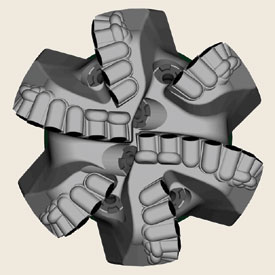New Bit Designs
Varel International
PDC line for rotary steerable systems improves drilling efficiency
Varel has developed a technique to fine-tune its drilling tools to the drive system and the delivered well trajectory. SPOT 3D is a cutting force analysis tool that can be used not only to force balance a PDC drill bit cutting structure, but it can also be used to adjust the lateral aggressiveness of the cutting structure to match the needs of the drive system and well trajectory.
The company has applied this technology to create the Navigator series of PDC bits. The series includes bits for Point-the-Bit rotary steering systems, Push-the-Bit systems and conventional PDM (positive displacement motor) set-ups. Bits for each system are designed to accommodate the peculiarities of each drive system. The results are bits that maximize the performance and control of the drilling operation. The wellbore is completed on time and on target.
“S” feature. Often in directional drilling, drillers encounter loss of tool-face and stalling; Varel's “S” feature reduces these. Available on the Navigator series, the “S” feature is a protrusion positioned behind the PDC cutter, engineered to adjust bit drilling aggressivity. This feature contains no diamond or other cutting elements. The locations on the blade and quantity are determined by the directional application. In field tests in various locations around the world, the “S” feature has limited over-torque and stalling, resulting in reduced drilling time.
 |
To reduce over-torque and stalling, the “S feature,” a protrusion positioned behind the PDC cutter, has been engineered to adjust bit drilling aggressivity.
|
|
Improved bits for hard rock applications. By examining dull bits used to drill hard and abrasive formations, Varel engineers have determined that excessive sliding by tungsten carbide inserts against the rock being drilled is the primary reason for rapid dulling in such applications. In instances studied, excessive wear of the gauge, and drive rows, of rock bits ended bit life prematurely. Harder grades of tungsten carbide do not solve this problem, as inserts made from harder grades are generally too brittle and fail even earlier, due to gross insert breakage.
Varel engineers analyzed the motions of bit teeth acting against the borehole bottom in hard rock applications and found that a significant amount of sliding is caused by the hole bottom geometry. They further found that, by changing the spacing of the bit teeth within the rows, the sliding could be greatly reduced or eliminated.
They tested their findings by selecting an application in Russia, where conventional 8-1/2-in. diameter IADC 637Y bits were failing prematurely while drilling dense limestones and dolomites. In this application, each bit would drill about 650 m in 66 hr before failing, due to worn outer rows. The typical dull grading for bits run in this application was 6 8 WT A I E NO PR.
An experimental 8-1/2 IADC 637Y rock bit, designed to minimize sliding of the outer row bit teeth against the borehole bottom, was developed. In the same application in Russia, five such bits averaged 954 m per bit, with an average bit life of 101 hr. The typical dull grading for these five bits was 8 5 BT M I E WT PR.
The bit designed to minimize sliding achieved 46% more meters than conventional bits. The primary dulling characteristic was different from conventional bits, with middle row insert failure determining bit life instead of the outer rows. The company is presently testing several other sizes and types of bits utilizing this concept. 
|



